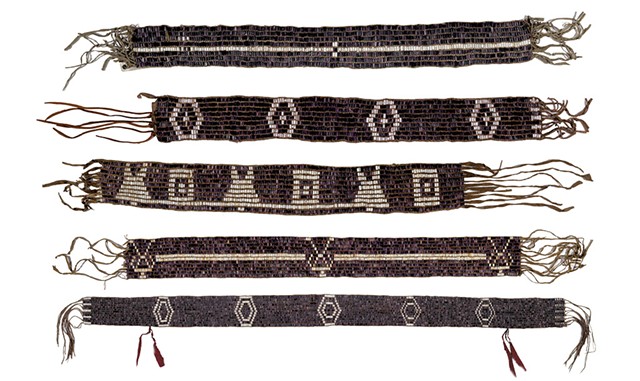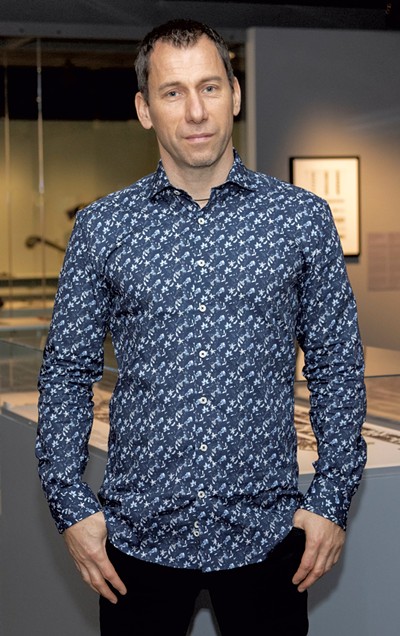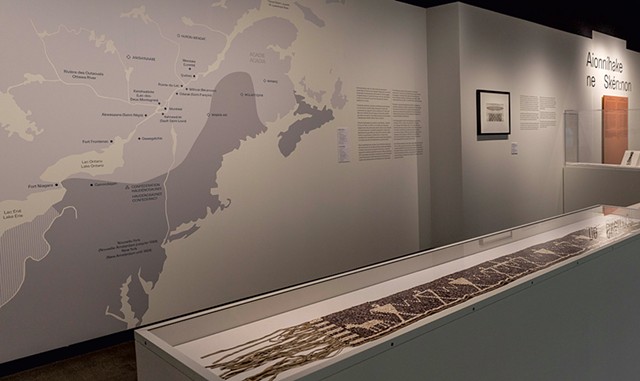
- Courtesy
- Wampum belts, Eastern Woodlands, 18th century. Gift of David Ross McCord.
When four Huron-Wendat leaders from the Québec City area traveled to England in 1824 to assert their land rights to British monarch King George IV, they carried with them a souvenir of past alliances between the two peoples. In their luggage was a beaded belt, or wampum, known as the Great War Belt. Its beads depicted a war hatchet, a symbol of the Huron-Wendat nation's earlier military support for the British as they contended with French forces. It was a pointed reminder: You owe us.
Today, that belt is in the permanent collection at Montréal's McCord Stewart Museum and is currently on display in the exhibition "Wampum: Beads of Diplomacy." Developed in collaboration with the Musée du quai Branly-Jacques Chirac in Paris, the exhibition features objects held in public and private collections across Canada and Europe. This is an unprecedented chance to see them at once.
"To my knowledge, [there have never been] 40 belts displayed for the public all together," said Huron-Wendat curator Jonathan Lainey, who has researched wampums for 20 years.
Wampum are tubular beads made from white and purple quahog shells, which were used and traded across northeastern North America from the early 17th through the 19th centuries. The beads were woven into belts that served to cement treaties and seal agreements. Words were considered sincere only when accompanied by a wampum.
At the museum, the Great War Belt is displayed next to an 1825 lithograph depicting the Huron grand chief Nicolas Vincent Tsawenhohi during the trip to England. He's holding the wampum aloft and pointing at it, as if to ensure that his audience understands its significance.
The pairing illustrates wampums' power, and the exhibition is an invitation to consider their fundamental role in relationships between Indigenous and European nations, as well as their continued resonance today.
A wall display provides a code to reading the symbols woven into the belts: Red pigments symbolize war, for example. A diamond represents a nation, people or council fire.
"When you see three human figures linked by a chain, you know it's an alliance between three groups," Lainey said, pointing to an 18th-century belt of unknown provenance. "But who are [they]? That's the part we don't know."

- Courtesy
- Jonathan Lainey
The exact meaning of many belts has been lost. "In the old days, people were bringing these belts [out] publicly ... and explaining them for hours, for days, so that everyone could recognize them visually and remember the message," Lainey explained. "But since wampums [have been] in museums for 100 years or more, this message was not repeated."
He added that transmitting the belts' meanings was rarely of interest to collectors, who saw them as "an example of these 'vanishing races.'"
Moving from one room to the next, a viewer follows the evolution of the belts, from those commemorating early, nation-to-nation diplomacy to versions sent to European religious institutions adorned with Latin script. The belts vary in size — the largest, the Two Dog Wampum, is more than 6.5 feet long and 27 rows wide — but each is intricately patterned. Alternating purple and white beads depict luminous geometric designs or figures that look modern, in spite of their sometimes age-worn edges.
Future visitors have unfortunately missed one of the exhibition's most notable pieces. A wampum belt presented by Christians from the Mohawk community of Kanesatake to Pope Gregory XVI, held by the Vatican since 1831, was on display for just five weeks. Securing the brief loan from the Vatican, Lainey said, was complicated.
For some Kanesatake community members, though, it was a once-in-a-lifetime opportunity to see the belt held and displayed by the Vatican. It also provided an opportunity for them to approach the Vatican's representative and start a discussion about possibly returning the belt to its place of origin.
That question of repatriation lingers: Should these wampum belts be held in museums at all? Exhibition notes remark that, as Indigenous people were forcibly assimilated, wampum belts stopped being used. And some impoverished community members sold them to collectors — perhaps without the authorization to do so. However, Lainey argued that repatriation is not quite so simple as "giving them back."
Referring to about two-thirds of the 40 wampum belts, he said, "we don't know where they're from, why they were sold and by whom. We are open to repatriating objects, but ... we want to make sure we give [them] to the appropriate people.
"It's our hope that this exhibition will be a springboard for discussion," Lainey continued. "If people recognize their objects, they can say, 'Hey, this is my community's, my nation's, my great-great-grandfather's.' Let's spark these discussions."

- Courtesy Of Roger Aziz
- "Wampum: Beads of Diplomacy" installation view
The exhibition's penultimate room gathers wampum-inspired artworks by contemporary Indigenous artists. Huron-Wendat artist Teharihulen Michel Savard's "Reciprocity" (2009) is a haunting expression of the breakdown of Canadian-Indigenous diplomacy. The mixed-media sculpture shows a copy of the Indian Act, created in 1876 to assimilate First Nations, which the artist took into the forest and shot with a gun. Out of the bullet hole spill acrylic wampum beads, which, the panel explains, "helped record the alliances and treaties violated by the Canadian government."
In her 2022 piece "Wampum Presented by xox to the Queen (nail polish version)," Mohawk multimedia artist Skawennati seems to gesture to the Tsawenhohi lithograph shown elsewhere in the exhibition. With hot-pink nail polish-painted wampum beads woven into a belt, Skawennati imagines a meeting between her digital avatar, named xox, and Queen Elizabeth II.
In the artwork, xox presents the monarch with the famed Two Row Wampum, a common wampum belt design of two parallel lines that was, as a panel notes, "created to remind Europeans that we had agreed to live together ... without interfering in each other's governance."
"As we know, this agreement was broken," Skawennati wrote in an email. "xox intended to tell the queen that she needed to make reparations for the problems they caused when they limited our freedom of movement, outlawed our ceremonies and languages, replaced our traditional governments and took our children. Unfortunately, the queen died before xox could give her the message."
Skawennati, who is best known for her virtual artworks, said xox plans to meet King Charles III in cyberspace this year. ("Charles once gave a speech as a hologram, so I know he has an avatar," she noted.)
This pairing of contemporary artworks with centuries-old objects suggests that long-quieted wampums still have something to say. Those late 19th-century collectors believed they were gathering vestiges of disappearing cultures; the exhibition makes the case that the heirlooms, like the cultures that crafted them, are not relics belonging to the past. Wampums are not just artifacts; they are living reminders of alliances that far predate the founding of either Canada or the United States.
We often talk of land treaties, Lainey said, but first came treaties of peace, friendship, alliance. "If these treaties never existed, then the country as we know it would have been different. Or nonexistent," he said.
Wampum belts are still relevant, wrote Skawennati, reminding us of "the agreements we make between individuals, groups and nations."










Comments
Comments are closed.
From 2014-2020, Seven Days allowed readers to comment on all stories posted on our website. While we've appreciated the suggestions and insights, right now Seven Days is prioritizing our core mission — producing high-quality, responsible local journalism — over moderating online debates between readers.
To criticize, correct or praise our reporting, please send us a letter to the editor or send us a tip. We’ll check it out and report the results.
Online comments may return when we have better tech tools for managing them. Thanks for reading.